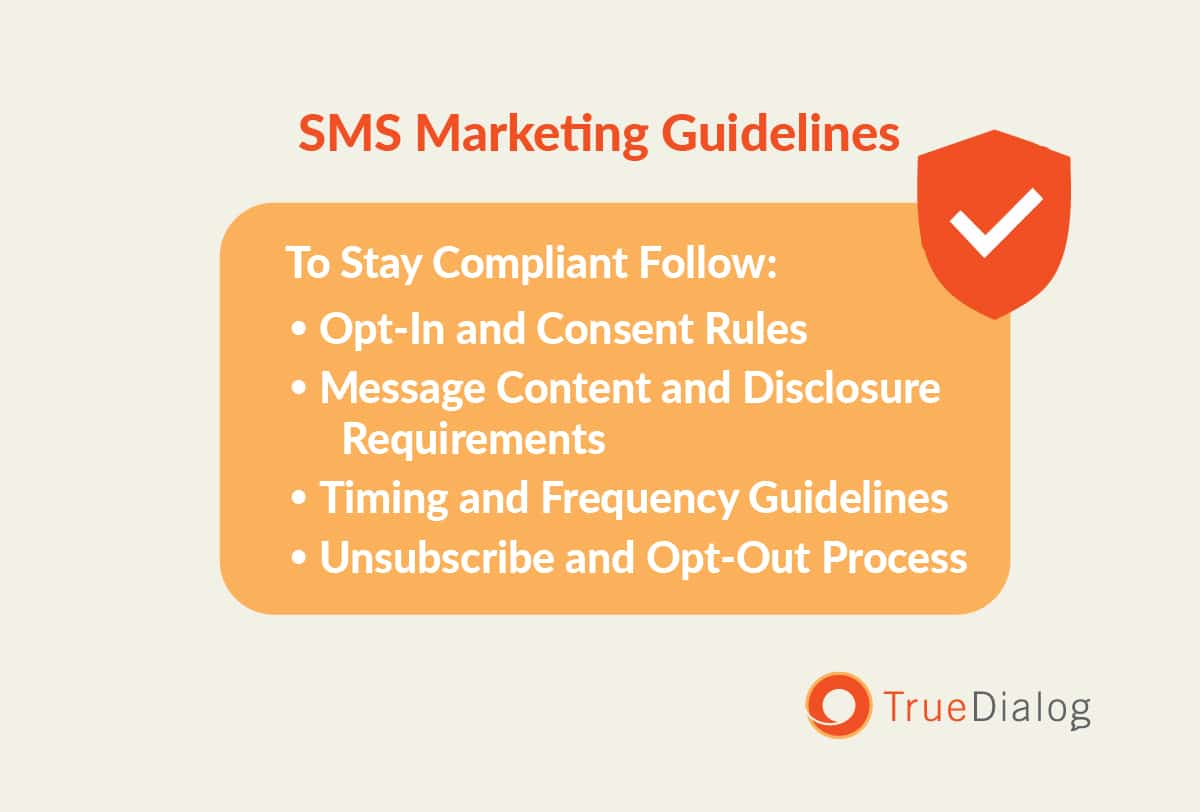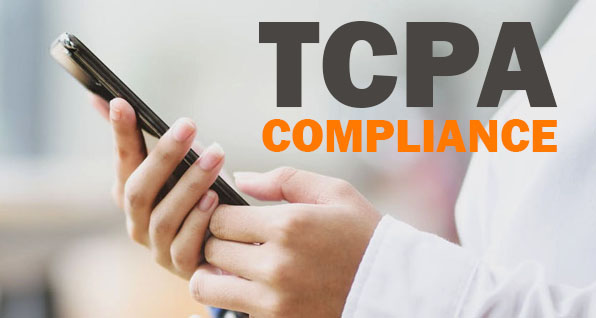Legal disclaimer: This guide is provided for informational purposes only and should not be considered legal advice or used as a substitute for advice from a qualified legal professional. Following this guide does not guarantee compliance.
There’s no denying that text messaging is one of the fastest and most reliable ways to connect directly with your audience and generate huge returns — so long as you follow the rules.
As with any marketing channel, businesses are required to follow numerous regulations when they send SMS messages. In fact, as a telecommunications channel, texting is held to slightly stricter compliance standards than you may be accustomed to with other digital channels — and failing to follow these regulations could land your organization in hot water.
Now that we’ve thoroughly scared you, here’s the good news: by taking time to understand SMS marketing compliance requirements (and working with an SMS platform like TrueDialog that has features to help you mitigate your risk), you can send messages with confidence.
In this guide, we’ll cover the basics of SMS rules and regulations, run through an SMS compliance checklist, and cover a few ways you can ensure you stay compliant.
What Is SMS Marketing Compliance?
SMS compliance refers to meeting the legal and ethical industry standards set forth by regulatory bodies to protect consumers from spam, unwanted contact, and data misuse. But these laws don’t just benefit recipients — following regulations can also help businesses build trust with their audience and maintain integrity in their marketing efforts. In other words, these frameworks help ensure that your texts reach people in the right way.
Why Compliance Matters for Business Messaging
For some businesses, it’s tempting to see SMS legal requirements as just another regulatory checkbox — something leaders do begrudgingly while looking for loopholes to exploit. But violating these laws won’t just leave you with a slap on the wrist. Failing to comply with industry regulations for SMS marketing can lead to severe legal consequences that tarnish your brand’s reputation and irreparably damage customer trust.
Not to mention, it can be incredibly expensive. For example, brands that violate the Telephone Consumer Protection Act (TCPA) may face fines of up to $1,500 per message — and that’s in addition to potential class-action lawsuits. Plus, if you consistently fail to meet SMS marketing compliance regulations, you could permanently lose your messaging privileges with mobile carriers, effectively silencing your brand on this channel forever.
That said, following these rules isn’t just about avoiding costly penalties or maintaining good standing with carriers — it’s also good business practice. When done right, taking the steps to stay compliant can help you strengthen audience relationships and boost long-term loyalty.
Key Regulatory Bodies and Laws
There are a few different regulatory bodies responsible for communicating mandates and ensuring business text message compliance, several different laws and guidelines, and a whole lot of acronyms.
To help you make sense of it all, here’s a quick primer:
- FCC (Federal Communications Commission)
The FCC is an independent agency of the U.S. government responsible for regulating communications across radio, television, cable, telephone, and other media channels. In terms of SMS, the FCC is primarily concerned with protecting consumers from illegal or unsolicited marketing messages. - TCPA (Telephone Consumer Protection Act)
This U.S. law lays the foundation for SMS marketing by governing how businesses can send messages (especially promotional texts). Enforced by the FCC, the TCPA mainly focuses on getting explicit consent from text recipients, honoring message opt-outs, and maintaining transparent communication practices. - CTIA (Cellular Telecommunications Industry Association)
The CTIA collaborates closely with wireless carriers to protect consumers from spam and abuse, and to enforce best practices. While it’s an industry trade group (rather than a government agency), it still carries significant weight. If your business fails to follow CTIA standards, carriers may block your messages from reaching your contacts. - GDPR (General Data Protection Regulation)
The European Union developed this law to mandate how businesses collect, store, and use personal data (including phone numbers) and ensure that organizations properly communicate their data use to their audiences. It’s essential to comply with GDPR if you communicate with individuals in the EU or intend to expand into European markets in the future. - CAN-SPAM Act
Although this law is primarily focused on transparency, truthfulness, and easy opt-outs for email communications, it can still apply to SMS marketing — such as when you send messages via email-to-text gateways or send multi-channel campaigns. (Check out the FTC’s CAN-SPAM compliance guide here.) - State-Specific Privacy Laws
While there are several federal and international laws to consider, it’s also a good idea to keep up with state laws. For example, the California Consumer Privacy Act (CCPA) and the California Privacy Rights Act (CPRA) grant California residents specific rights over their personal data and require businesses to honor consumer requests to access, delete, or opt out of having their data sold. - CASL (Canada’s Anti-Spam Legislation)
This strict anti-spam law requires businesses to obtain clear consent before sending commercial texts, fully identify themselves when sending messages, and keep detailed records of contacts’ opt-in and opt-out preferences. While CASL primarily focuses on promotional content, this legislation may also apply to some transactional and service-based messages. - PECR (Privacy and Electronic Communications Regulations)
This law complements GDPR and has a more specific focus on digital communications (like SMS). PECR outlines SMS opt-in requirements for marketing texts, as well as rules around message content and timing. - Australia’s Spam Act
Like many other countries’ anti-spam legislation, Australia’s Spam Act requires businesses to obtain explicit consent before sending SMS messages, clearly identify themselves in every message, and provide a functional option for unsubscribing. It’s enforced by the Australian Communications and Media Authority (ACMA) — a regulatory body known to charge steep fines for noncompliance. - Mobile Network Operator (MNO) Requirements
Mobile carriers also have their own rules for SMS traffic, which typically build upon CTIA guidelines. These requirements cover throughput (the rate at which messages can be sent within a given timeframe), sender identification, consent management, and prohibited content.
- TCR (The Campaign Registry)
This is a centralized hub that works closely with mobile network operators to manage and vet U.S. commercial text message campaigns. In order to use a 10-digit long code (10DLC) or dedicated short code, businesses must register with a campaign service provider (CSP), which then submits the company’s information to the TCR for verification and approval.
(To streamline this experience, TrueDialog offers an automated 10DLC registration feature that reduces approval timelines from weeks to days.)
Core SMS Compliance Requirements
While the specifics of each law may vary by governing body or geographic region, many regulations and industry guidelines overlap — especially when it comes to protecting consumers from intrusive and unwanted messages. For example, most requirements include rules around consent, data usage transparency, respecting contacts’ boundaries, and honoring opt-outs.
Here are a few best practices for meeting these core requirements:
Opt-In and Consent Rules
You should never send marketing messages to individuals without getting their permission. And, according to most SMS marketing compliance requirements, that permission has to be explicit — which means the recipient must knowingly agree to receiving messages from your organization with a clear affirmative, like checking a box or texting a specific keyword to your number.
In some cases, brands use a double opt-in process, which confirms consent twice. For example, a business might offer users an opportunity to opt in to text messages by sharing their number in a website pop-up, then confirm again in the welcome message. (For example, Reply Y to Subscribe or N to Cancel.) In addition to ensuring you have evidence of explicit consent, including this second step also helps ensure numbers are not invalid or inactive.
Note that this is different from implied or implicit consent, which is when someone shares their contact information with a company, such as during a checkout process, but does not expressly agree that the business can use their information for marketing purposes. Inferring that someone is open to receiving promotional content because they willingly shared their contact detail is a violation of many of today’s regulations.
(Additionally, pre-checked boxes are also not considered a valid form of explicit consent.)
Message Content and Disclosure Requirements
For many people, suddenly receiving text messages from an unknown number — especially promotional messages — can feel like an invasion of their personal space and lead to feelings of distrust. (Which is why most recipients are quick to block these numbers or report messages as junk.)
To help reduce SMS spam, many regulatory bodies now require brands to provide clear disclosures as soon as someone consents to SMS marketing (usually in the first text message they send). These disclosures should state your organization’s name, what kind of messages you’ll be sending, and, in some cases, how often a recipient can expect to hear from you.
For example, a bank might send the following opt-in confirmation message:
ABC Bank here! You’re subscribed to marketing SMS & account alerts. 2 – 4 msgs/month. Reply HELP for support or STOP to cancel. Msg & data rates may apply.
Timing and Frequency Guidelines
No one wants to be bombarded with an avalanche of messages or disturbed by notifications in the middle of the night. And while most marketers know that communicating too often or sending promotions after hours will inevitably destroy engagement and hurt their brand’s reputation, some businesses can’t help but push their luck.
To help prevent organizations from abusing their texting privileges, lawmakers have set clear restrictions around when a business can send promotional texts. For example, the TCPA prohibits businesses from sending marketing messages between 9 p.m. and 8 a.m. (in the recipient’s local time zone). Additionally, some states have imposed laws that restrict the number of messages a business can send recipients about the same subject in a single day — and many carriers have guidelines around messaging frequency to prevent spamming.
Unsubscribe and Opt-Out Process
People’s needs, interests, and habits change, and it’s vital that consumers can retain control over their text inbox. That’s why one of the most common SMS legal requirements is an easy unsubscribe process.
To help keep consumers in the driver’s seat, brands are required to provide clear, simple, and easy-to-follow mechanisms for opting out as soon as someone subscribes (or, in some cases, within every message). In many cases, subscribers can opt out by responding to texts with the word “STOP” or “CANCEL.”
When a contact opts out, brands must immediately cease all marketing texts, remove them from all SMS marketing lists, and send a confirmation message to the contact. (For example: You have been unsubscribed from our marketing SMS messages. No further messages will be sent.)
In addition to mitigating your legal risks, making sure your contacts know they can cancel at any time will make them feel more comfortable subscribing to your SMS promotions in the first place.
SMS Compliance Checklist
In many cases, following SMS compliance laws has the added advantage of helping increase message deliverability and fostering audience trust. But keeping up with so many rules and stipulations can also feel overwhelming — especially when you consider the steep penalties for failing to comply.
One of the best ways to ensure you’re covered is by creating a well-structured SMS marketing compliance process. This checklist outlines a few of the most essential areas to include in your process (including places where organizations inadvertently slip up) and provides practical steps you and your team can follow to make sure you’re compliant.
Permission-Based List Building
Consent is the bedrock of SMS marketing compliance — and without a proper opt-in method, you risk violating regulations with your very first message to a contact (and potentially damaging your brand’s reputation before you’ve even gotten your SMS marketing program off the ground).
- Collect explicit consent before sending any texts.
-
- Use straightforward language that explains exactly what the subscriber is agreeing to receive.
(Example: By signing up, you agree to receive promotional SMS messages from XYZ Tech.) - Send a follow-up text message to confirm consent and ensure the number is active.
(Example: Reply Y to Complete Your Subscription.) - Make sure you are not using any pre-checked boxes during the SMS opt-in process.
- Keep SMS opt-in consent separate from other agreements (i.e., email opt-ins or agreements to general terms of service).
- Use straightforward language that explains exactly what the subscriber is agreeing to receive.
Storing Consent Records Securely
While you hope your organization’s marketing and communication practices will never fall under scrutiny, it’s crucial to stay prepared. Audits, regulatory investigations, and mobile carrier reviews will likely require you to share when, where, and how an individual opted in to your SMS marketing, and well-kept records can serve as proof that you’ve obtained consent from every contact on your list.
- Maintain clear documentation of marketing SMS opt-ins and opt-outs.
-
- Keep detailed records of each opt-in, including the date, time, and source (i.e., text-in campaign or website form).
- Store opt-in records in a secure and centralized system.
- Keep all consent logs (even if a customer relationship has ended).
- Ensure only authorized personnel have access to contact data.
- Make sure records can be easily accessed, downloaded, and/or exported when needed.
- Regularly back up your consent data.
- Keep all marketing lists clean and up-to-date.
Proper Identification in Messages
It’s important that your contacts always know who is contacting them — and why you’re in their inbox.
- Ensure clear identification and contact expectations.
- Ensure only authorized personnel have access to contact data.
- Identify your brand in the very first message you send.
- Identify your brand in every message thereafter.
- Set clear expectations about message frequency.
- Include all required disclosures if/when applicable.
(Example: Msg & data rates may apply.) - Avoid using vague or generic language, and only include well-known abbreviations.
(Example: “Msg” is a commonly accepted abbreviation for message, but your audience may not know that “svc” refers to “service.”) - Use a recognizable and verified sender ID (i.e., a registered short code or 10DLC).
Managing Replies and Opt-Outs
Many regulatory bodies take opt-outs just as seriously as opt-ins, and failing to honor unsubscribe requests can lead to plenty of headaches. Ensure your SMS policy allows subscribers to opt out of receiving messages at any time.
- Provide a simple opt-out process.
-
- Include clear instructions for opting out in every message.
(Example: Reply STOP to unsubscribe.) - Make sure your business SMS platform automatically stops all sends to numbers that have opted out.
- Expressly confirm opt-outs with a follow-up message.
(Example: You’ve been unsubscribed. You will not send any further marketing messages from the university.) - Regularly review your opt-out lists to make sure they’re current and properly synced across systems (like, for example, your CRM or marketing automation software).
- Monitor reply messages and use keyword filters to catch misspellings or variations.
(Example: Even if your opt-out instructions say to use the word “STOP,” your contacts may respond “CANCEL,” “QUIT,” or “UNSUBSCRIBE” — or a misspelling of any of these words.)
- Include clear instructions for opting out in every message.
How TrueDialog Helps You Stay Compliant
Of course, even if you’re committed to following regulations and creating a carefully outlined plan, keeping up with SMS marketing compliance can be a lot of work — especially if you’re handling these steps manually or relying on overly simplistic or outdated tech. Fortunately, TrueDialog has plenty of built-in SMS compliance tools and processes designed to help you meet core requirements, protect your data, and maintain brand integrity.
Automate with SMS Compliance Tools
Using a registered short code or 10DLC will not only help you stay compliant with industry regulations, but it also ensures that your messages can be reliably delivered. Unfortunately, completing TCR registration can take weeks — especially if you’re stuck with an SMS platform that relies on Twilio (which is often busy serving countless other providers’ customers). To help, TrueDialog has automated this process, enabling you to register long codes (and short codes) in just a few days.
Plus, thanks to native integrations with Salesforce, HubSpot, Marketo, and other top CRMs and marketing automation programs, it’s easy to sync data across systems and ensure your contact lists always reflect the latest opt-ins and opt-outs.
Control Settings with Platform Administration
It’s important that only trained and authorized individuals have access to customer data and compliance logs. That’s why TrueDialog offers easy platform administration with controls that allow administrators to decide who can view and use different features and functionalities, and customize profile settings at the user level with an intuitive drag-and-drop interface. This way, you never have to worry about someone inadvertently putting your organization at risk or letting sensitive information fall into the wrong hands.
Manage Opt-Ins with Contact Management
Keeping your lists updated and well-organized is essential to proving compliance for text messages — especially when it comes to opt-in consent. TrueDialog’s Contact Database helps you securely store and manage your contacts, and the Activity Records feature provides a comprehensive overview of account activity (so you can easily keep track of opt-outs). Additionally, you can choose between single or double opt-in methods, and the platform helps you deliver hassle-free opt-out experiences to keep your lists clean and compliant.
Monitor Campaigns Using SMS Reporting
TrueDialog’s SMS reporting tools provide real-time insights into performance metrics — such as deliverability and click-through rates — as well as list health, user activity, and more. With message logs, you can review message history and track specific interactions to make sure your organization is following regulations (and easily access proof of compliance if your practices are called into question). Plus, each campaign includes its own status update log, so you can make doubly sure that you’re honoring opt-outs.
Stay Confident and Compliant in Every Campaign
When it comes to SMS marketing compliance, you never want to take chances. Make sure you always have explicit consent before sending texts, be transparent, respect your contacts’ boundaries, honor their requests if they decide to unsubscribe — and keep clear, updated records that prove you’re doing all of the above. By staying up-to-date on regulations and adopting an enterprise SMS platform like TrueDialog that’s committed to security and compliance, you can send SMS campaigns with confidence.






